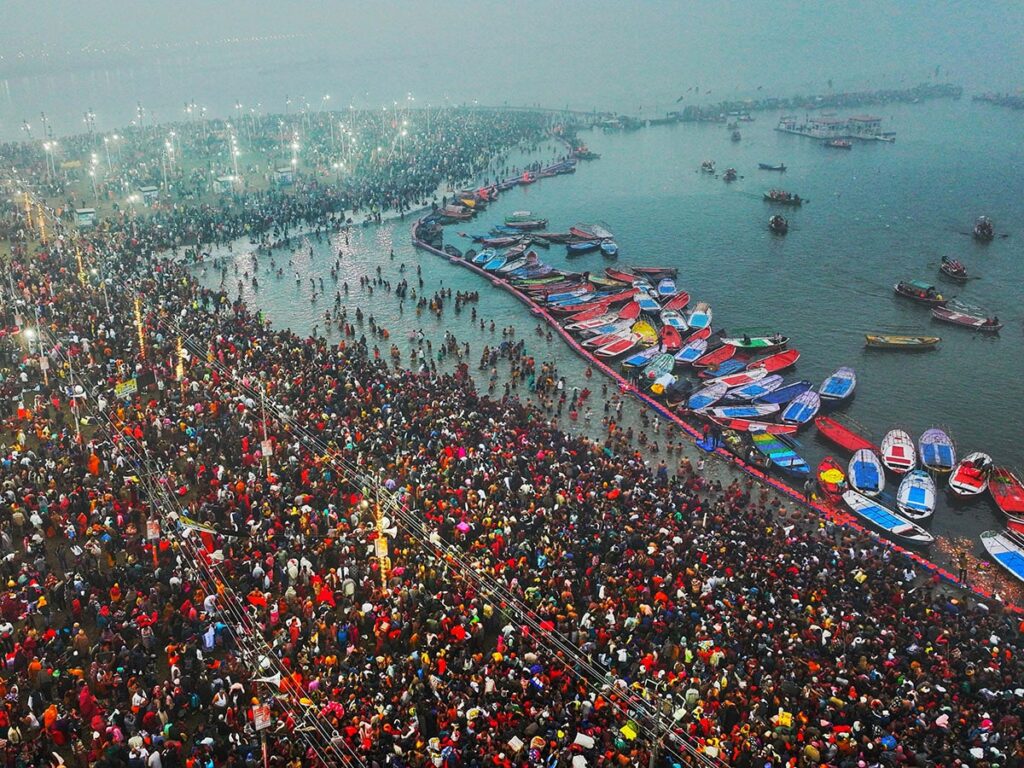
The Mahakumbh Mela is one of the most spiritually significant gatherings in Hindu tradition, attracting millions of devotees, saints, and spiritual seekers from around the world. Its importance stems from mythology, astrology, and its role in Hindu spiritual practices.
Spiritual Significance:
- Amrit (Nectar) from the Ocean of Milk:
The origins of the Kumbh Mela come from the Samudra Manthan (Churning of the Ocean) in Hindu mythology. When the gods (Devas) and demons (Asuras) churned the ocean for Amrit (nectar of immortality), drops of nectar spilled at four places—Prayagraj, Haridwar, Ujjain, and Nashik. These places became the sacred sites for the Kumbh Mela, where taking a dip in the holy rivers is believed to cleanse sins and grant moksha (liberation). - Astrological Significance:
The timing of the Mahakumbh Mela is determined by planetary positions. It occurs when Jupiter (Brihaspati) enters Aquarius (Kumbha Rashi) and the Sun enters Aries (Mesha Rashi). This celestial alignment is believed to create a powerful energy field that enhances spiritual purification. - Spiritual Cleansing and Liberation (Moksha):
Bathing in the sacred rivers (Ganga, Yamuna, Saraswati at Prayagraj; Godavari at Nashik; Shipra at Ujjain; and Ganga at Haridwar) during the Kumbh Mela is believed to wash away sins from past lives, freeing devotees from the cycle of rebirth (Samsara). - Spiritual Gathering of Saints and Sages:
The Mahakumbh Mela is a rare occasion where sadhus, yogis, and spiritual masters from different Hindu traditions—including Nagas (ascetic warriors), Udasin, Vaishnav, Shaivite, and Shakta sects—gather. This provides a unique opportunity for devotees to receive blessings and spiritual wisdom from enlightened beings. - Collective Consciousness and Devotional Power:
Millions of people chanting, meditating, and engaging in rituals create a high-energy spiritual environment that is believed to amplify prayers and personal spiritual efforts.
Why is Mahakumbh Mela Important?
- It is the largest religious gathering in the world, symbolizing the deep-rooted faith of Hindus.
- It fosters unity among different sects, saints, and spiritual seekers.
- It offers an opportunity for self-transformation, deep meditation, and devotion.
- It preserves ancient Hindu traditions, philosophies, and knowledge.
Rituals and Traditions of Mahakumbh
—Mahakumbh Mela is not just a religious gathering; it is a grand spiritual event with deeply symbolic rituals. Here are the key aspects of its traditions:
- Shahi Snan (Royal Bath) – The Most Sacred Ritual
The Shahi Snan is the highlight of the Kumbh Mela, where revered sadhus and saints from different Akhadas (monastic orders) take a dip in the sacred river before the general public. It is believed that this bath purifies the soul and leads to moksha (liberation).
- The Naga Sadhus (ascetic warriors who live naked and smear ash on their bodies) lead the procession, followed by other monastic groups.
- The first bath is considered the most auspicious and takes place at the most astrologically significant moment.
- Snan (Holy Bathing) on Specific Dates
Apart from the Shahi Snan, devotees take ritual baths on specific dates based on the lunar calendar. Each bathing day has its own astrological significance and is believed to bestow divine blessings.
- Akhada Processions
The Kumbh Mela is a rare occasion when all the Akhadas (monastic sects) of Hinduism gather in one place. These include:
- Naga Sadhus (renunciates, known for their extreme austerities)
- Vaishnav Akhadas (followers of Vishnu)
- Shaiva Akhadas (followers of Shiva)
- Shakta Akhadas (followers of the goddess Shakti)
Each Akhada arrives in a grand procession with elephants, horses, and chariots, creating a mesmerizing spectacle.
- Pravachan and Satsang (Spiritual Discourses)
Renowned saints and spiritual leaders give discourses on Hindu scriptures like the Bhagavad Gita, Upanishads, Vedas, and Puranas. These sessions attract seekers eager to deepen their spiritual understanding.
- Yajnas (Fire Rituals) and Pujas
Elaborate yajnas (fire offerings) and pujas (worship ceremonies) are performed to invoke divine blessings, purify the atmosphere, and remove negative energies.
- Annadan (Charity and Feeding the Poor)
Massive community kitchens operate at the Mela, serving free food to thousands of pilgrims, ascetics, and the needy. This act of selfless service (Seva) is considered highly meritorious.
- Darshan of Sadhus and Spiritual Masters
Devotees get the rare opportunity to interact with enlightened beings who spend most of their lives in isolation in the Himalayas. Many share their teachings, and some demonstrate mystical powers (Siddhis).
- Initiations (Diksha) and Renunciation Ceremonies
Many individuals take spiritual initiation (Diksha) under a guru, pledging to follow a monastic life. Some even renounce worldly attachments and become sanyasis (monks).
Image Source: Google
